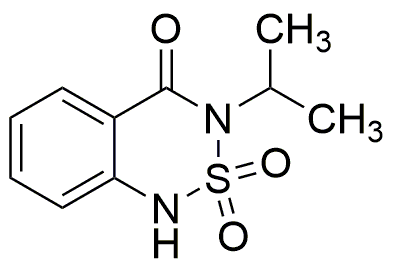Bentazon is widely utilized in research focused on:
- Agricultural Herbicide: Commonly used in agriculture, Bentazon effectively controls broadleaf weeds in crops like soybeans and peanuts, helping farmers maintain healthy yields.
- Environmental Studies: Researchers use Bentazon to study its environmental impact, particularly its behavior in soil and water, which is crucial for assessing herbicide runoff and its effects on ecosystems.
- Crop Protection Research: In plant science, Bentazon serves as a model compound for developing new herbicides, allowing scientists to explore more sustainable and effective weed management strategies.
- Analytical Chemistry: Bentazon is often analyzed in laboratories to develop and validate methods for detecting pesticide residues in food products, ensuring consumer safety and compliance with regulations.
- Phytotoxicity Studies: It is used in phytotoxicity tests to evaluate the potential harmful effects of herbicides on non-target plants, helping to inform safer application practices.
General Information
Properties
Safety and Regulations
Applications
Bentazon is widely utilized in research focused on:
- Agricultural Herbicide: Commonly used in agriculture, Bentazon effectively controls broadleaf weeds in crops like soybeans and peanuts, helping farmers maintain healthy yields.
- Environmental Studies: Researchers use Bentazon to study its environmental impact, particularly its behavior in soil and water, which is crucial for assessing herbicide runoff and its effects on ecosystems.
- Crop Protection Research: In plant science, Bentazon serves as a model compound for developing new herbicides, allowing scientists to explore more sustainable and effective weed management strategies.
- Analytical Chemistry: Bentazon is often analyzed in laboratories to develop and validate methods for detecting pesticide residues in food products, ensuring consumer safety and compliance with regulations.
- Phytotoxicity Studies: It is used in phytotoxicity tests to evaluate the potential harmful effects of herbicides on non-target plants, helping to inform safer application practices.
Documents
Safety Data Sheets (SDS)
The SDS provides comprehensive safety information on handling, storage, and disposal of the product.
Product Specification (PS)
The PS provides a comprehensive breakdown of the product’s properties, including chemical composition, physical state, purity, and storage requirements. It also details acceptable quality ranges and the product's intended applications.
Certificates of Analysis (COA)
Search for Certificates of Analysis (COA) by entering the products Lot Number. Lot and Batch Numbers can be found on a product’s label following the words ‘Lot’ or ‘Batch’.
*Catalog Number
*Lot Number
Certificates Of Origin (COO)
This COO confirms the country where the product was manufactured, and also details the materials and components used in it and whether it is derived from natural, synthetic, or other specific sources. This certificate may be required for customs, trade, and regulatory compliance.
*Catalog Number
*Lot Number
Safety Data Sheets (SDS)
The SDS provides comprehensive safety information on handling, storage, and disposal of the product.
DownloadProduct Specification (PS)
The PS provides a comprehensive breakdown of the product’s properties, including chemical composition, physical state, purity, and storage requirements. It also details acceptable quality ranges and the product's intended applications.
DownloadCertificates of Analysis (COA)
Search for Certificates of Analysis (COA) by entering the products Lot Number. Lot and Batch Numbers can be found on a product’s label following the words ‘Lot’ or ‘Batch’.
*Catalog Number
*Lot Number
Certificates Of Origin (COO)
This COO confirms the country where the product was manufactured, and also details the materials and components used in it and whether it is derived from natural, synthetic, or other specific sources. This certificate may be required for customs, trade, and regulatory compliance.


